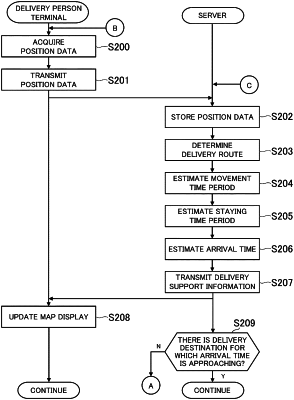| CPC G06Q 10/0833 (2013.01) [G01C 21/343 (2013.01); G01C 21/3691 (2013.01); G06F 16/29 (2019.01); G06N 20/00 (2019.01); G06Q 10/063114 (2013.01); G06Q 10/0838 (2013.01); G08B 21/18 (2013.01); G08G 1/205 (2013.01); H04W 4/029 (2018.02)] | 14 Claims |

|
1. A system for accurate guidance of a route for a mobile object, the system comprising:
at least one memory configured to store computer program code; and
at least one processor configured to access said at least one memory and operate according to said computer program code, said computer program code including:
via point acquisition code configured to cause the at least one processor to acquire a position of a via point, wherein the via point is a location of a planned interim stay on a route to a destination, wherein the route is a path followed by a mobile object when the mobile object moves toward the destination;
learning code configured to cause the at least one processor to train and adjust a machine learning model based on training data including feature information and staying times for each of a plurality of staying places, each of the plurality of staying places corresponding to a past destination in a history of position data of at least one user terminal, the position data indicating a relationship between a position of the at least one user terminal and a time, the position data having been accumulated from the at least one user terminal for storage in a database, the machine learning model being thereby trained, based on the position data, to describe a relationship between feature information of an input staying place and a staying time of the input staying place;
staying time period code configured to cause the at least one processor to estimate a staying time period for the via point, wherein the staying time period represents an estimate of a time that the mobile object will stay at the position of the via point, wherein the staying time period is estimated at least in part by inputting feature information on the via point to the machine learning model and acquiring the staying time outputted from the machine learning model; and
arrival time code configured to cause the at least one processor to estimate, in real time, an arrival time of the mobile object at the destination, wherein the mobile object is currently in motion and the real-time estimate of the arrival time is based at least in part on the staying time period,
wherein the route is adjusted based at least in part on the estimate of the arrival time, and information including the adjusted route is transmitted to a device associated with the mobile object to be displayed on a display of the device, and
wherein the staying time period for the via point is estimated a plurality of times prior to completion of the route, at least a first estimate of the staying time period being based on the history of position data before receipt of an additional position data point from the at least one user terminal, at least a second estimate of the staying time period being based on the history of position data after receipt of the additional position data point from the at least one user terminal.
|